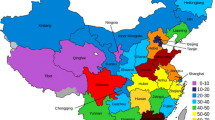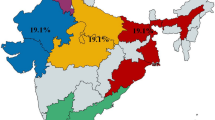Abstract
We examine India’s urban–rural inequality in welfare in 1993–1994 and 2004, a period which coincides with the country’s economic liberalization reforms and rapid economic growth. Using real monthly per capita household consumption expenditure as our measure of welfare, we estimate quantile regressions to analyze the urban–rural welfare gap across the entire welfare distribution. While the urban–rural welfare gap was fairly convex across the welfare distribution in 1993–1994, it became more concave in 2004, with the gap narrowing for the lowest and highest quintiles and widening for the middle three quintiles. The urban–rural gap in returns to all levels of education widened substantially for the bottom four quintiles but became increasingly negative for the top quintile. Applying the Machado and Mata (J Appl Econom 20:445–465, 2005) decomposition technique to decompose the urban–rural welfare gap at each percentile, we find that for the bottom 40% of the distribution, differences in the distribution of covariates became less important while differences in the distribution of returns to covariates became more important in explaining the gap. The opposite was true for the top 40% of the distribution. Our analysis suggests that while the rural poor appear to be catching up with their urban counterparts in terms of labor market characteristics, ten years of economic reforms have intensified the urban–rural gap in returns to these characteristics. On the other hand, the rural rich lag even further behind the urban rich with respect to their labor market characteristics even though the urban–rural gap in the returns to these characteristics has diminished during the reform period. Future efforts to generate urban–rural equality may require policies that seek to equalize returns to labor market characteristics between the two sectors at the lower half of the distribution and improve rural labor market characteristics at the top half of the distribution.
Similar content being viewed by others
References
Ahluwalia M (2002) State level performance under economic reforms in india. In: Krueger A (eds) Economic policy reforms and the indian economy. University of Chicago Press, Chicago
Albrecht J, Bjorklund A, Vroman S (2003) Is there a glass ceiling in Sweden. J Labor Econ 21: 145–177
Albrecht J, Nguyen B, Vroman S, Westbrook M (2006) A quantile regression decomposition of urban–rural inequality in vietnam. J Develop Econ 83: 466–490
Athanasopoulos G, Vahid F (2003) Statistical inference and changes in income inequality in Australia. Econ Rec 79: 412–424
Autor D, Katz L, Kearney M (2006) Rising wage inequality: the role of composition and prices, nBER Working Paper No. W11628
Banerjee A, Piketty T (2001) Are the rich growing richer: Evidence from Indian tax data, available at http://www.worldbank.org/indiapovertyworkshop
Blaise M (2007) Estimation of counterfactual distributions using quantile regression, Working Paper
Cameron AC, Trivedi PK (2005) Microeconometrics: methods and applications. Cambridge University Press, London
Cowell F (1995) Measuring inequality, 2nd edn. lSE handbook in economics series. Prentice Hall, London
Deaton A (1997) The analysis of household surveys: a microeconometric approach to development policy. Johns Hopkins University Press, Baltimore
Deaton A (2005) Adjusted Indian Poverty Estimates in 1999/2000. In: Deaton A, Kozel V (eds) Data and dogma: the great Indian poverty debate. Macmillan, New Delhi
Deaton A, Dreze J (2002) Poverty and inequality in India: a re-examination. Econ Polit Wkly 3729–3748
Ganguli I, Terrell K (2005) The gender gap in Ukraine’s transition, iZA Discussion Paper No. 1776
Ghosh J, Chandrasekhar C (2003) Per capita income growth in the states of India, available at http://www.macroscan.com/fet/aug03/fet100803SDP1.htm
Hall P (1994) Methodology and theory for the bootstrap. In: Engle R, McFadden D (eds) Handbook of applied econometrics, vol 4. North Holland, Amsterdam
Jha R (2004) Reducing poverty and inequality in India: has liberalization helped?. In: Cornia G (eds) Inequality, growth and poverty in an era of liberalization and globalization. Oxford University Press, New York
Machado J, Mata J (2005) Counterfactual decomposition of changes in wage distributions using quantile regression. J Appl Econom 20: 445–465
Machado J, Portugal P, Guimaraes J (2006) U.S. unemployment duration: has long become longer or short become shorter? iZA Discussion Paper No. 2174
Mitra A, Murayama M (2008) Rural to urban migration: a district level analysis for India, iDE Discussion Paper No. 137, Institute of Developing Economies
Sen A, Deaton A (2003) Poverty and inequality in India: getting closer to the truth. In: Deaton A, Kozel V (eds) Data and dogma: the great indian poverty debate. Macmillan, New Delhi
Singh N, Bhandari L, Chen A, Khare A (2003) Regional inequality in India: a fresh look. Econ Polit Wkly 1069–1073
Sundaram K, Tendulkar S (2003a) Poverty in India in the 1990s: an analysis of changes in 15 major states. Econ Polit Wkly 1385–1393
Sundaram K, Tendulkar S (2003b) Poverty in India in the 1990s: revised results for all-India and 15 major states for 1993–94. Econ Polit Wkly 4865–4872
Author information
Authors and Affiliations
Corresponding author
Rights and permissions
About this article
Cite this article
Chamarbagwala, R. Economic liberalization and urban–rural inequality in India: a quantile regression analysis. Empir Econ 39, 371–394 (2010). https://doi.org/10.1007/s00181-009-0308-4
Received:
Accepted:
Published:
Issue Date:
DOI: https://doi.org/10.1007/s00181-009-0308-4




